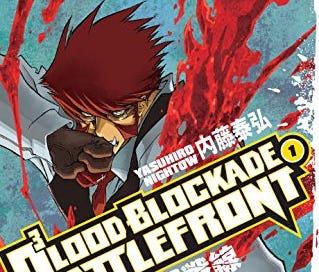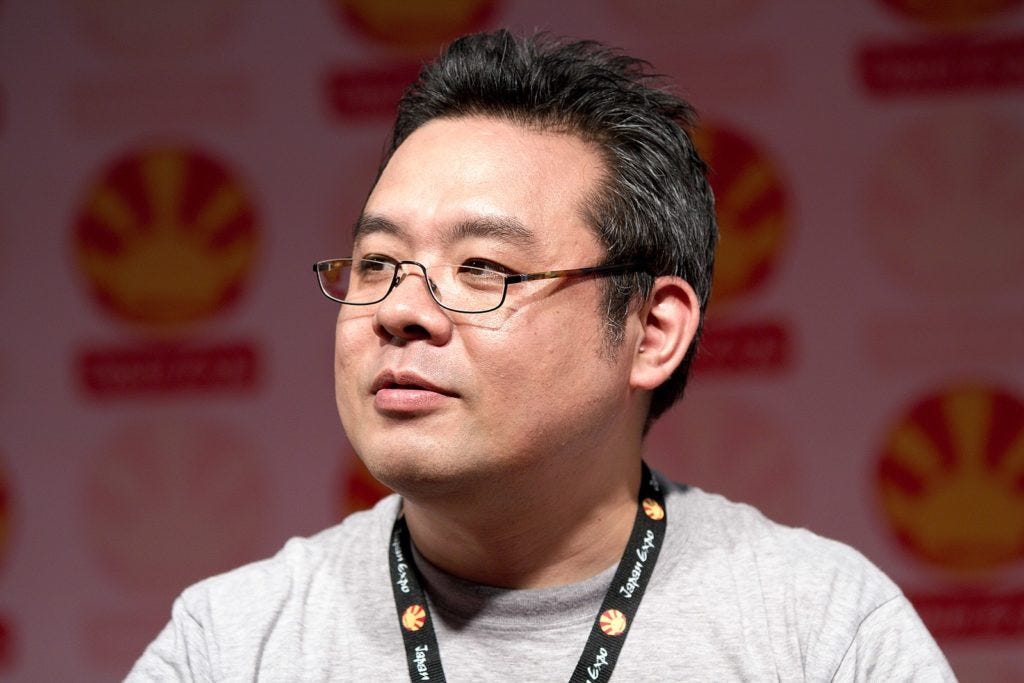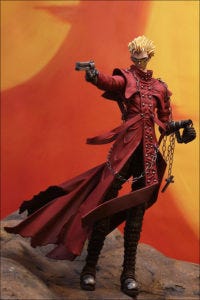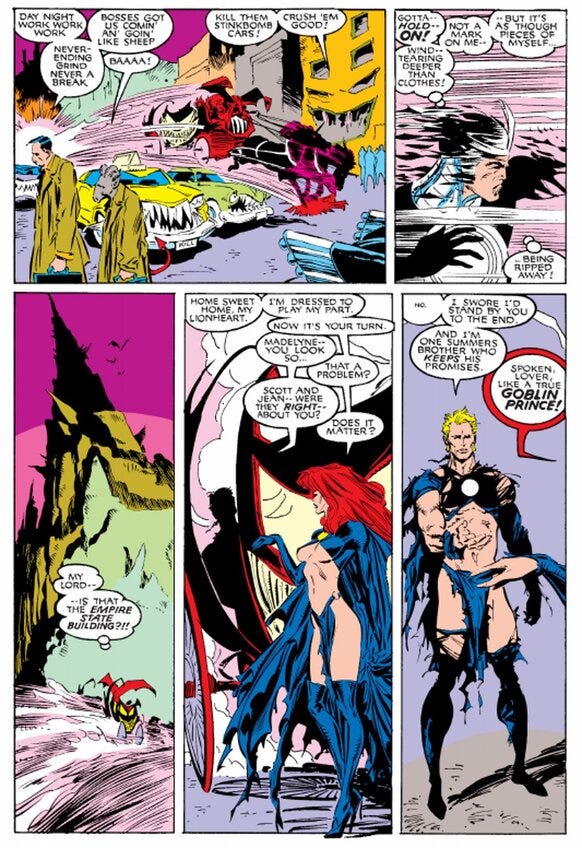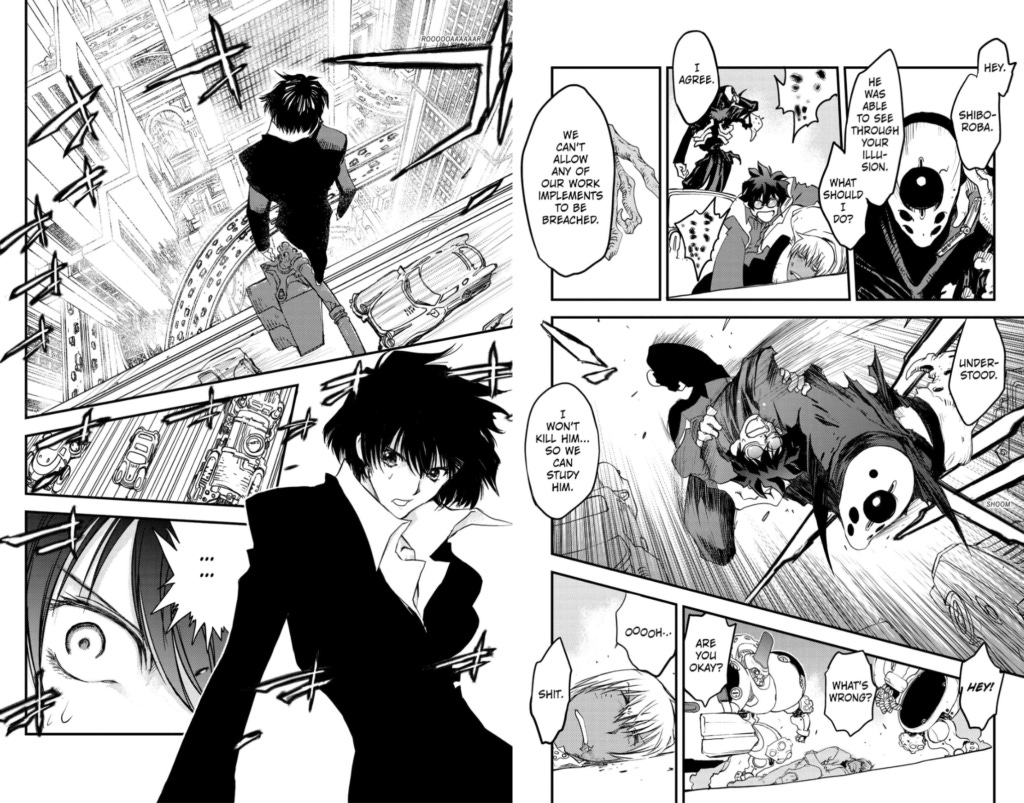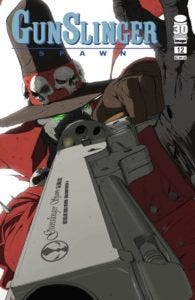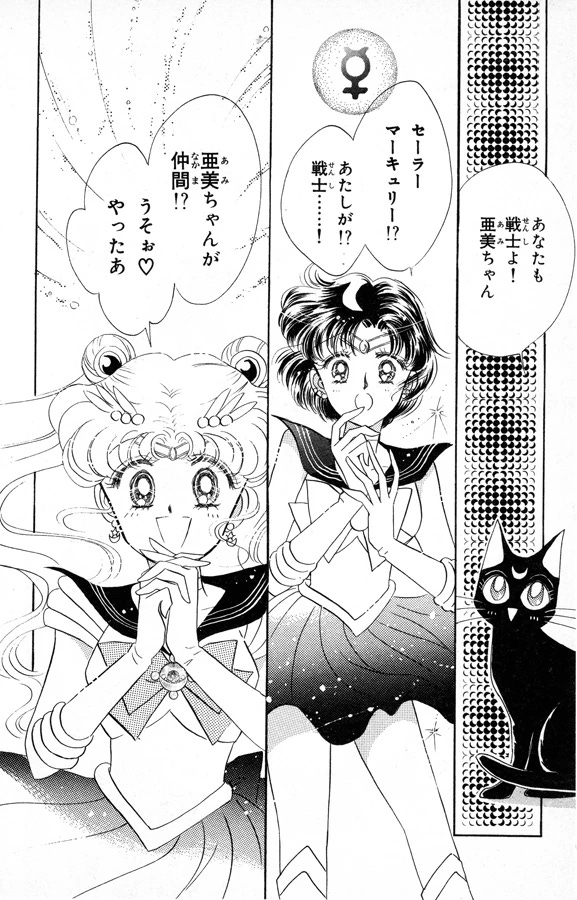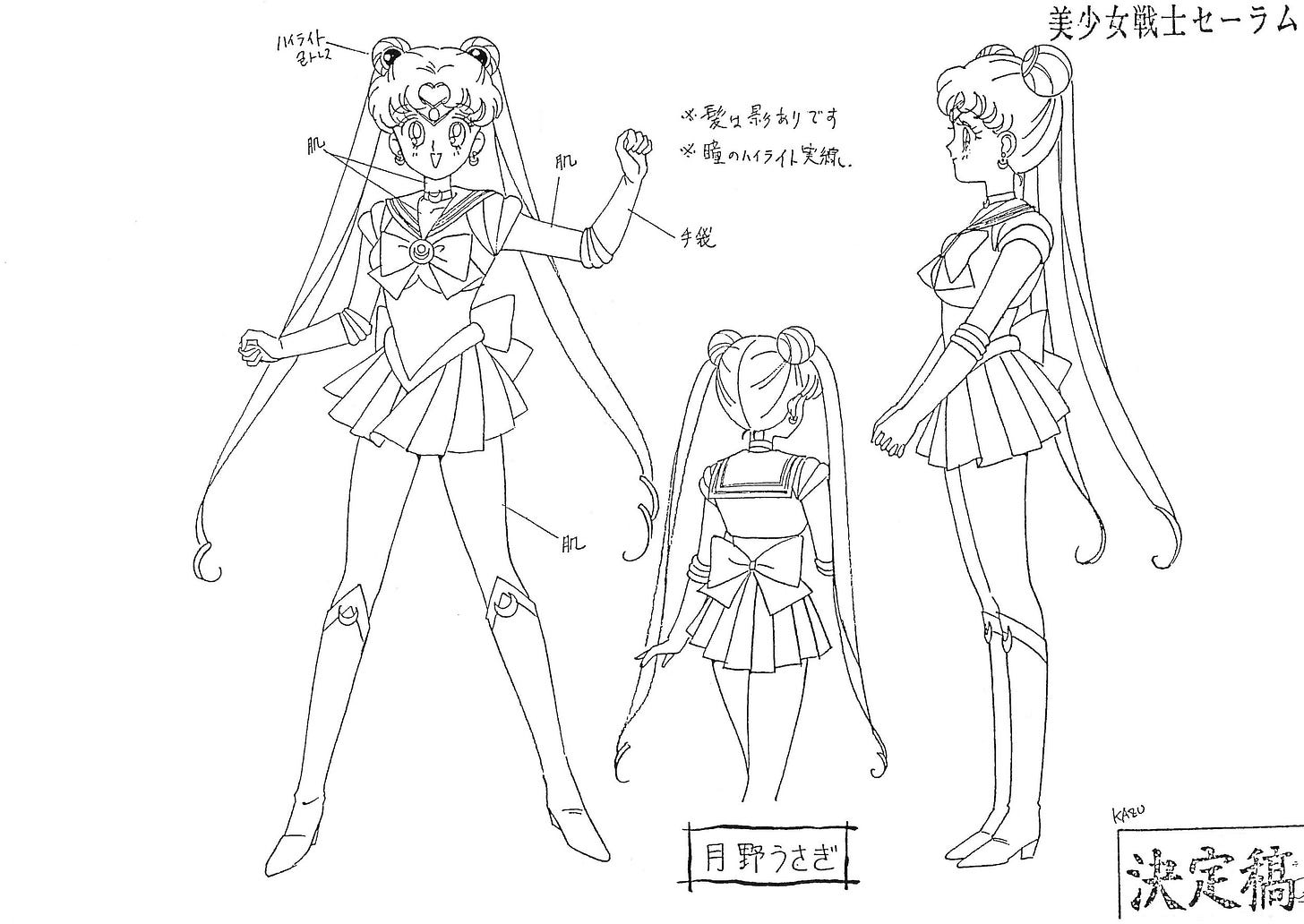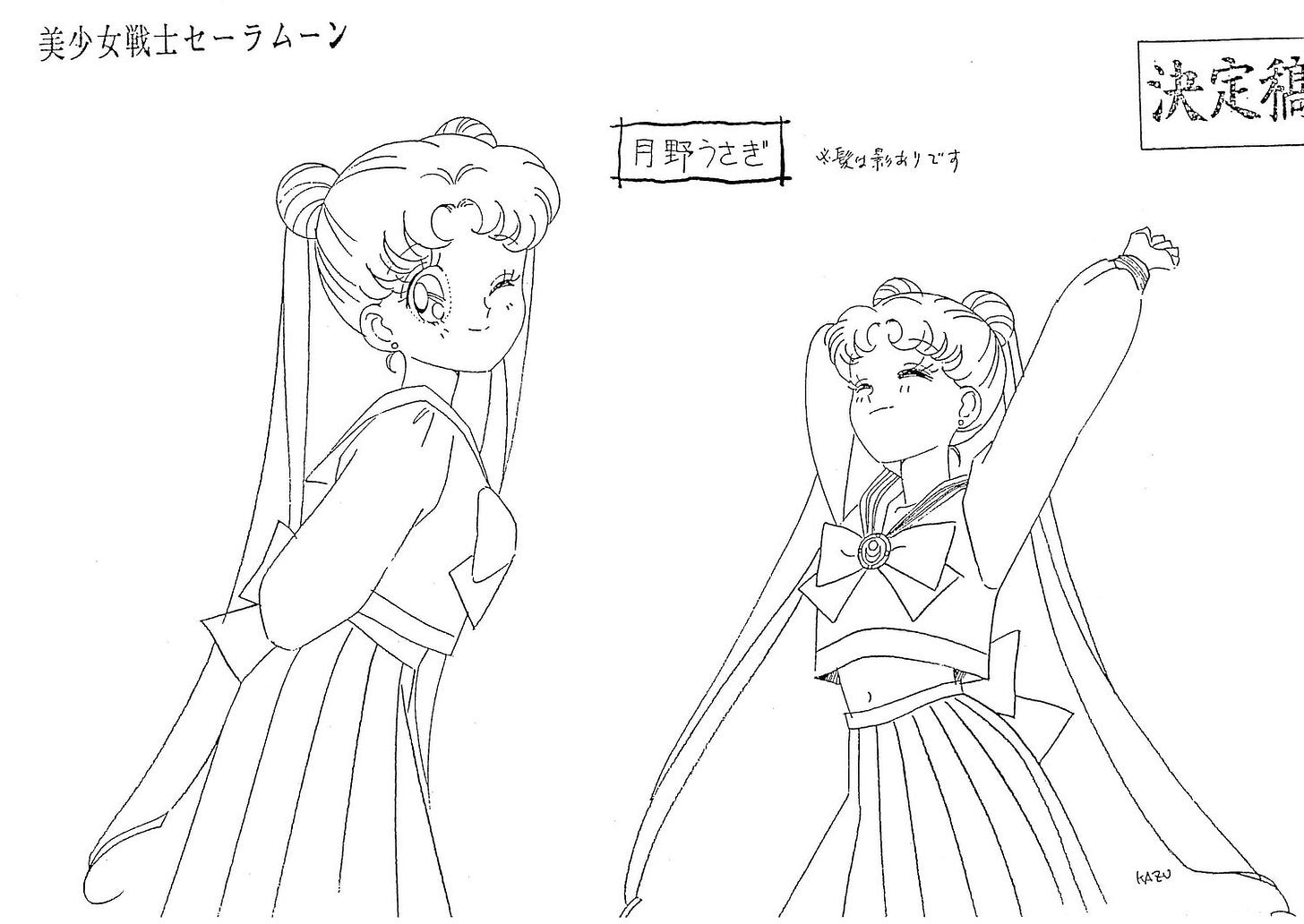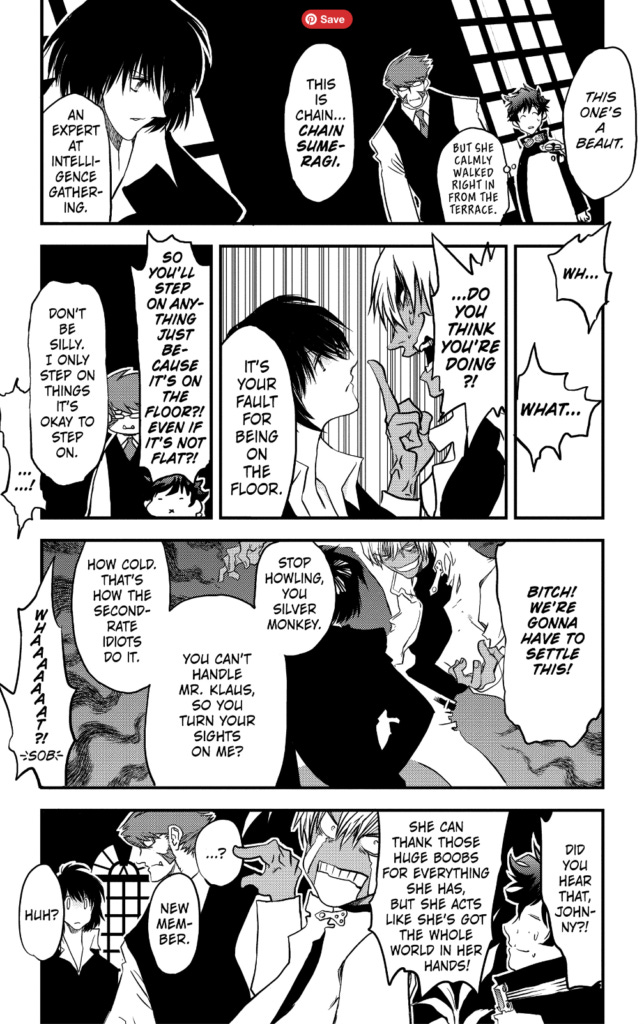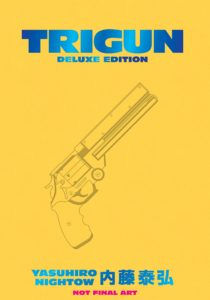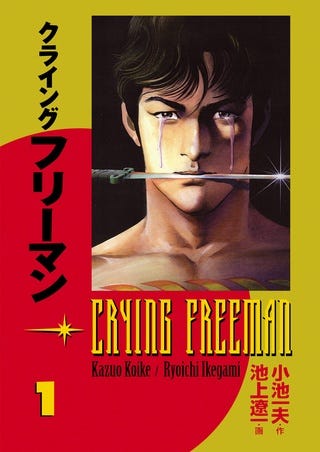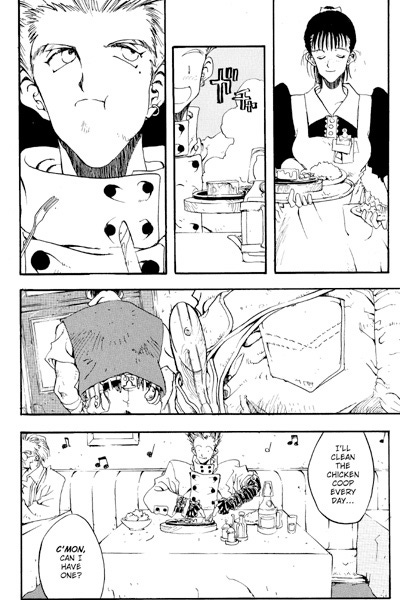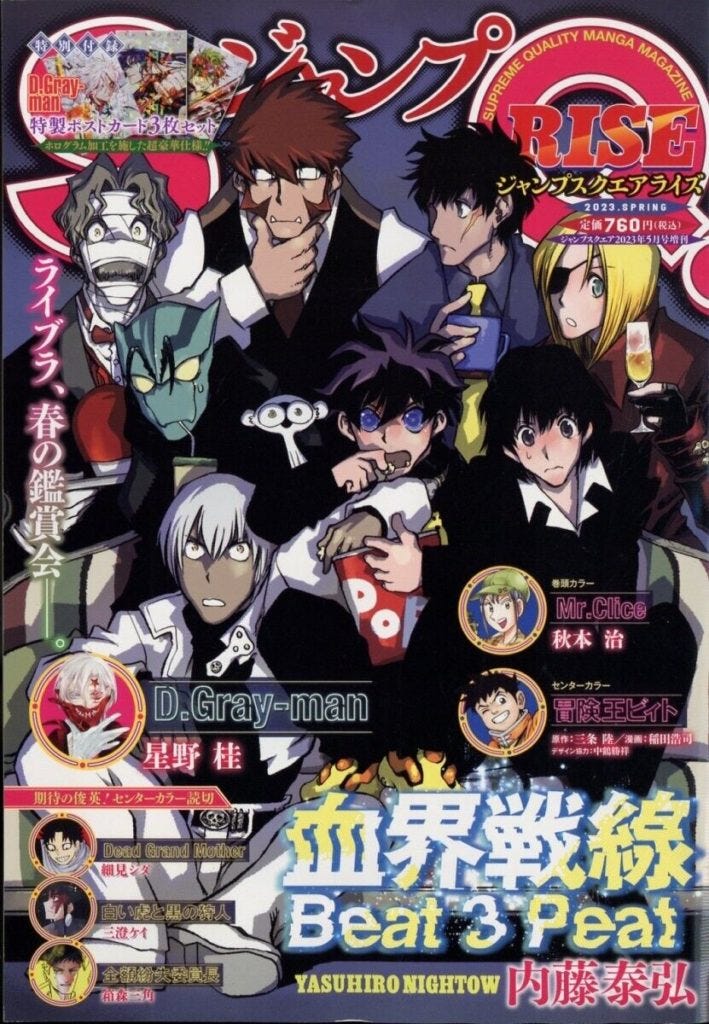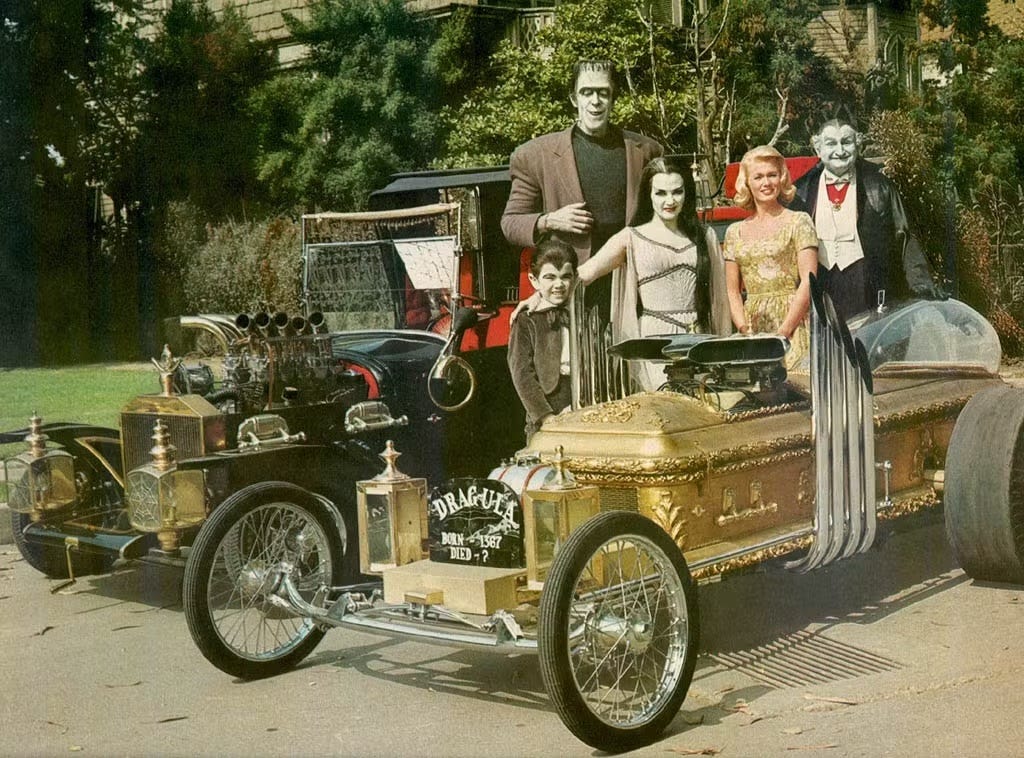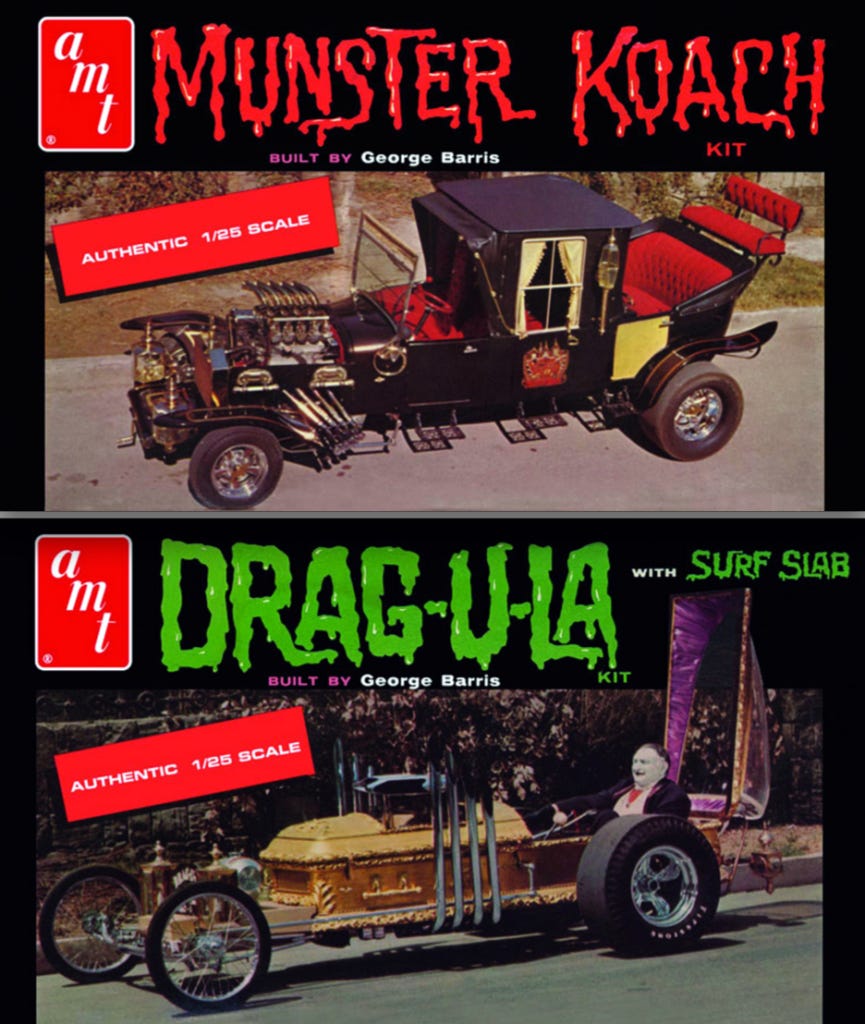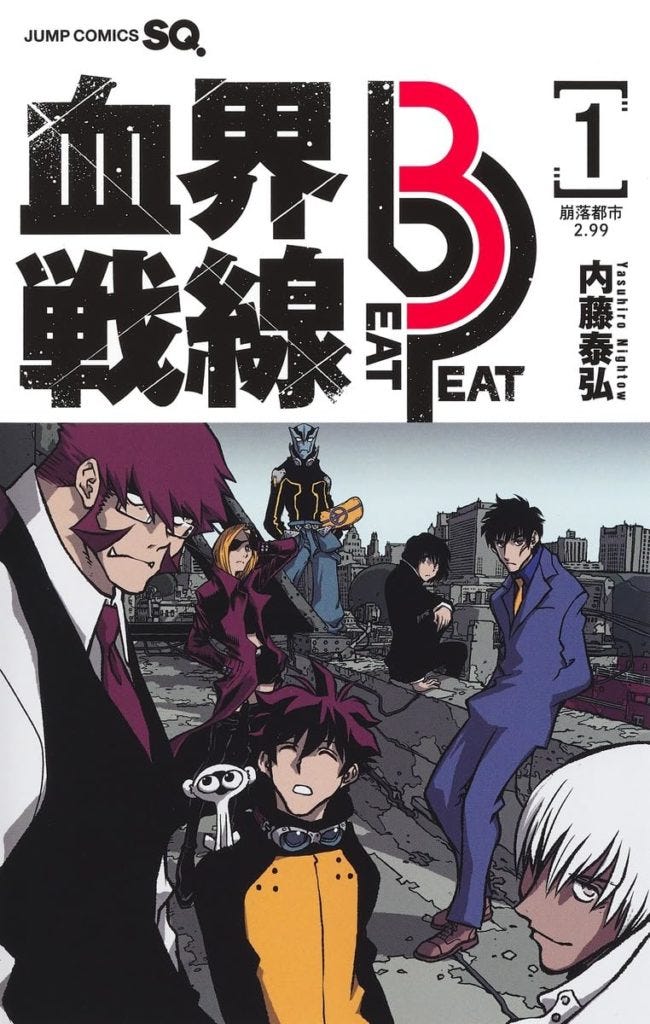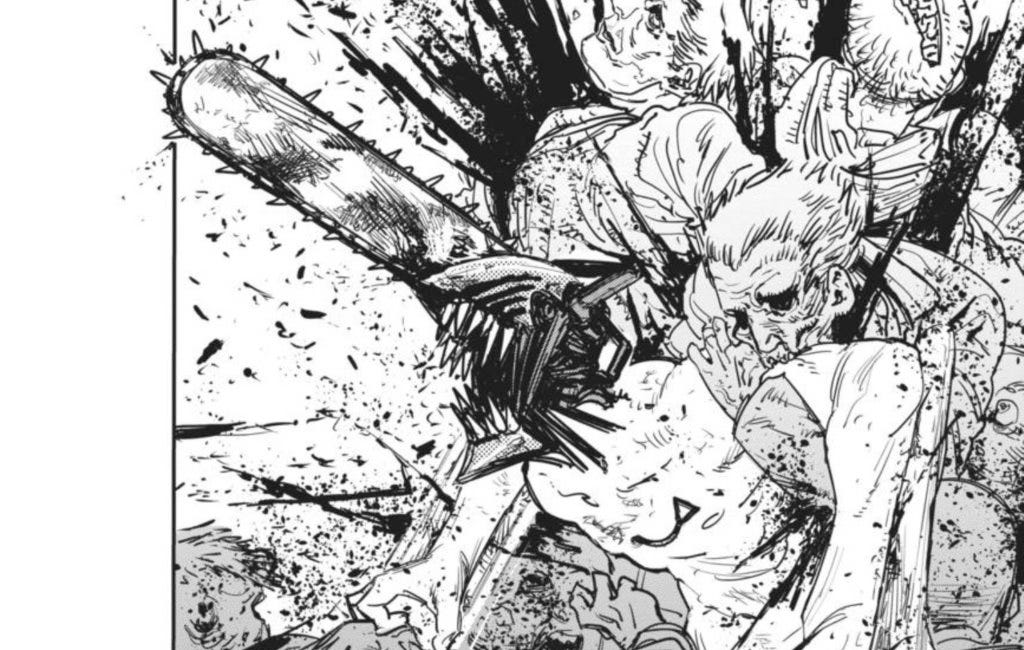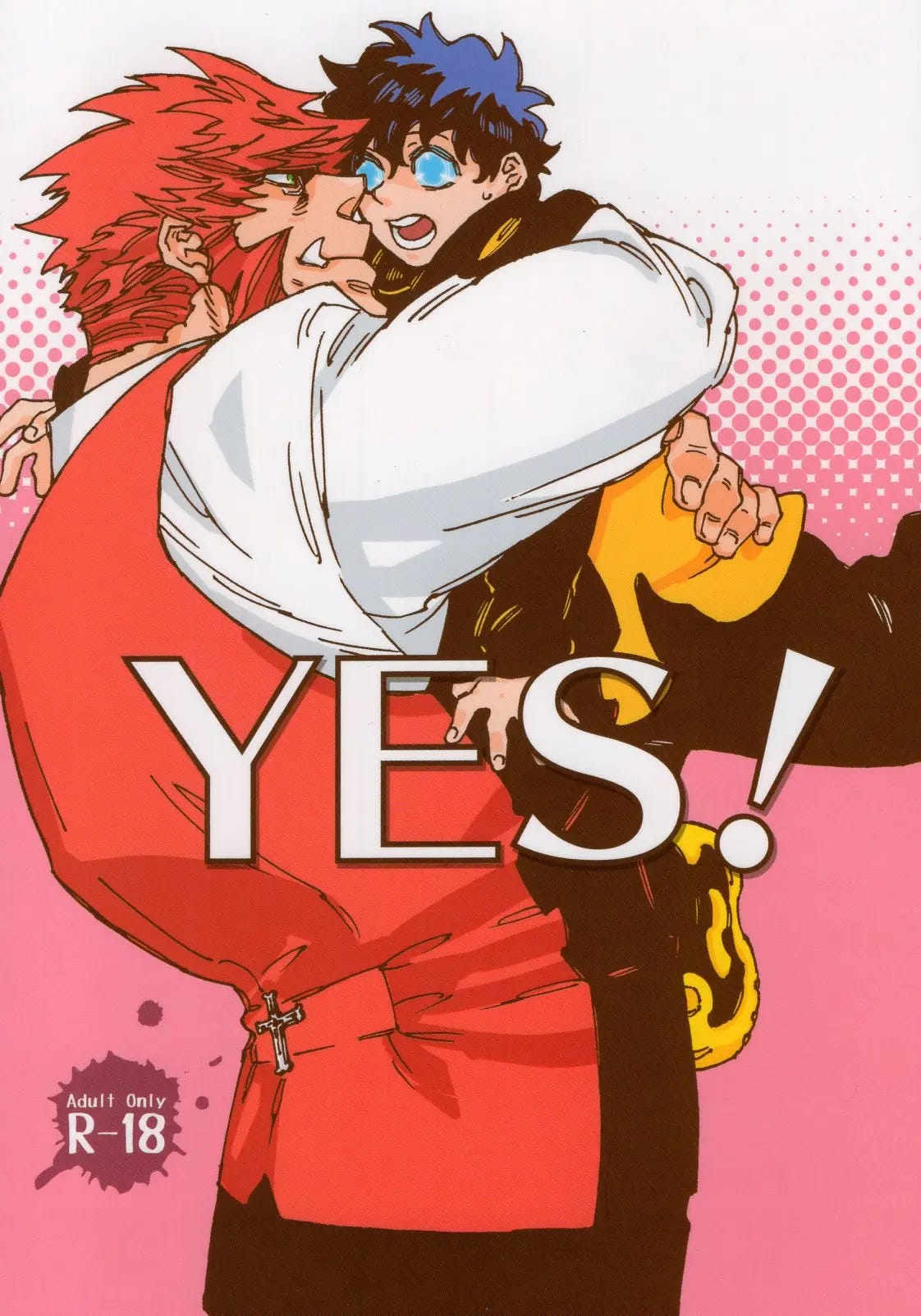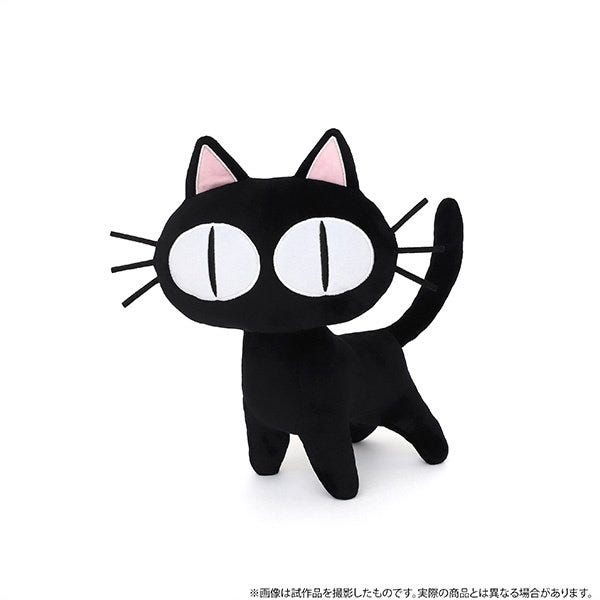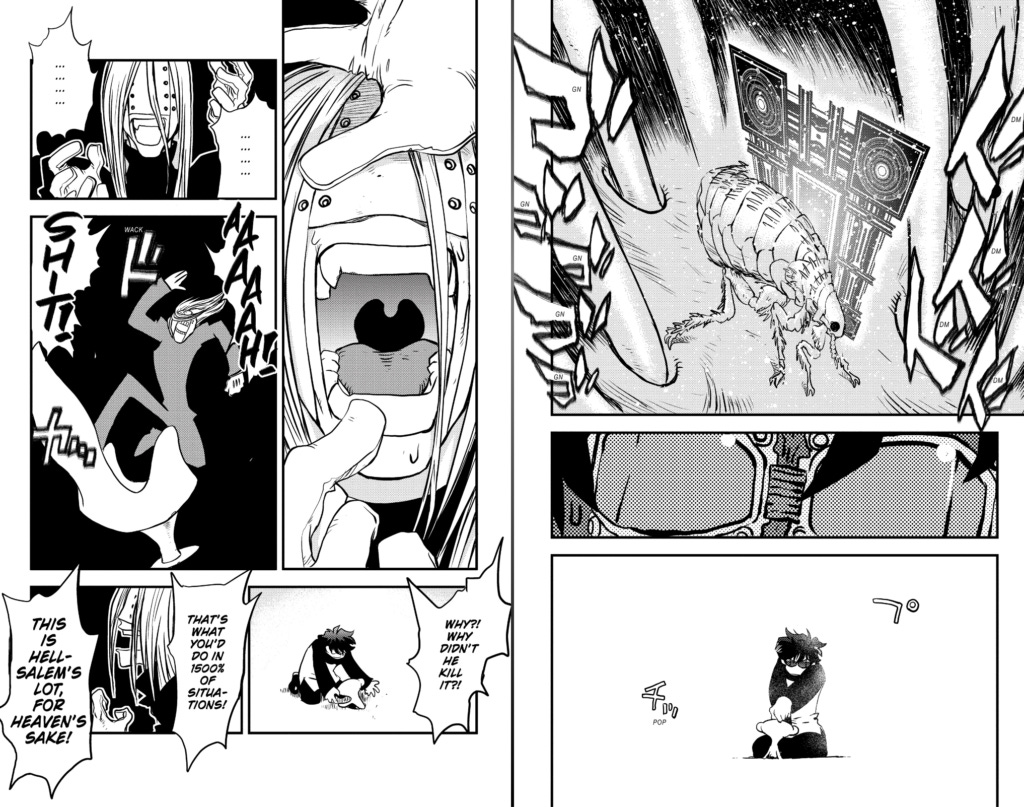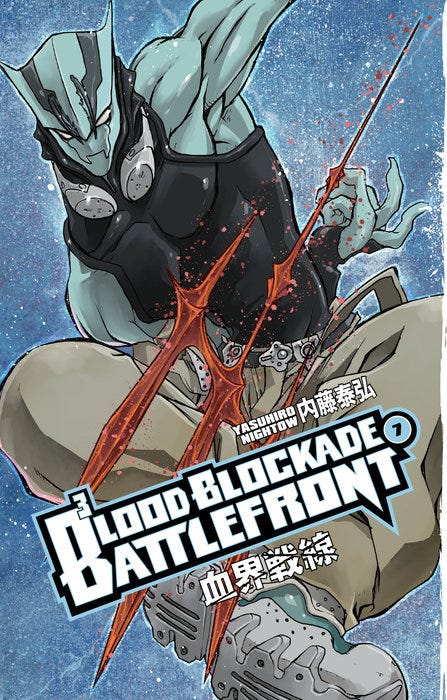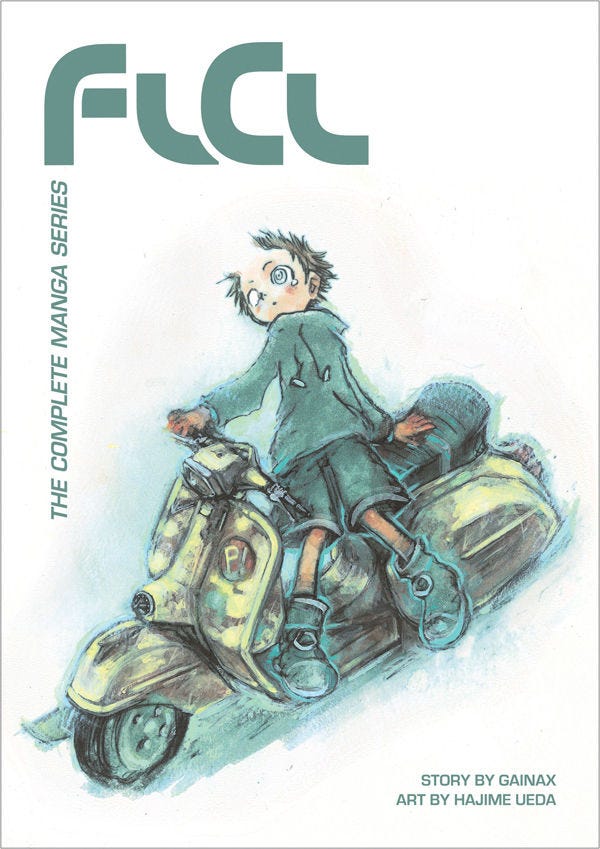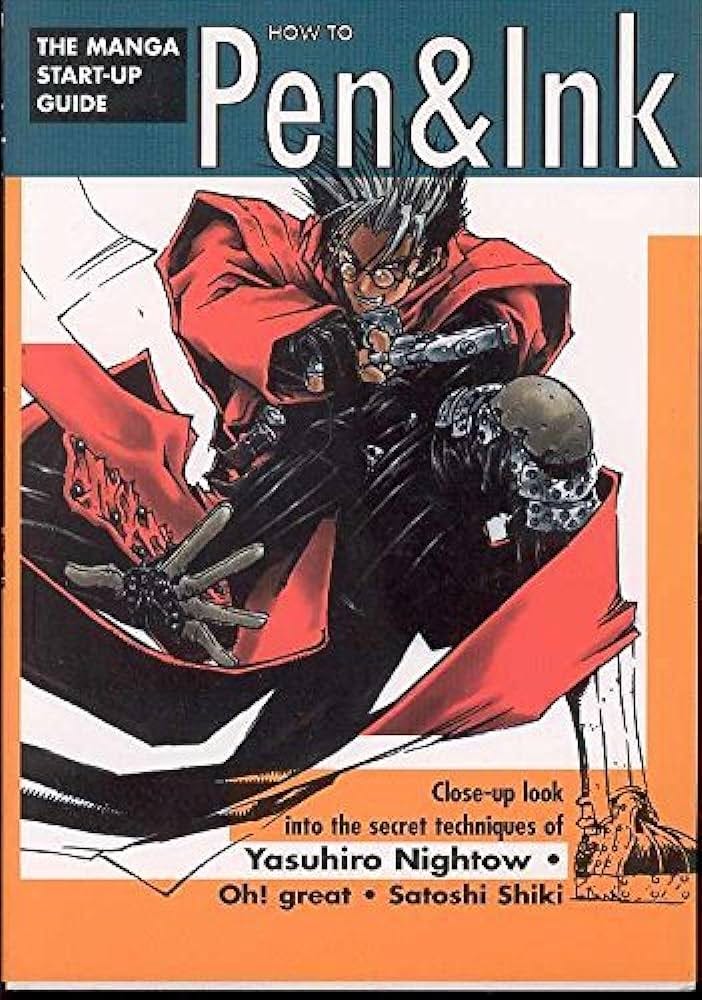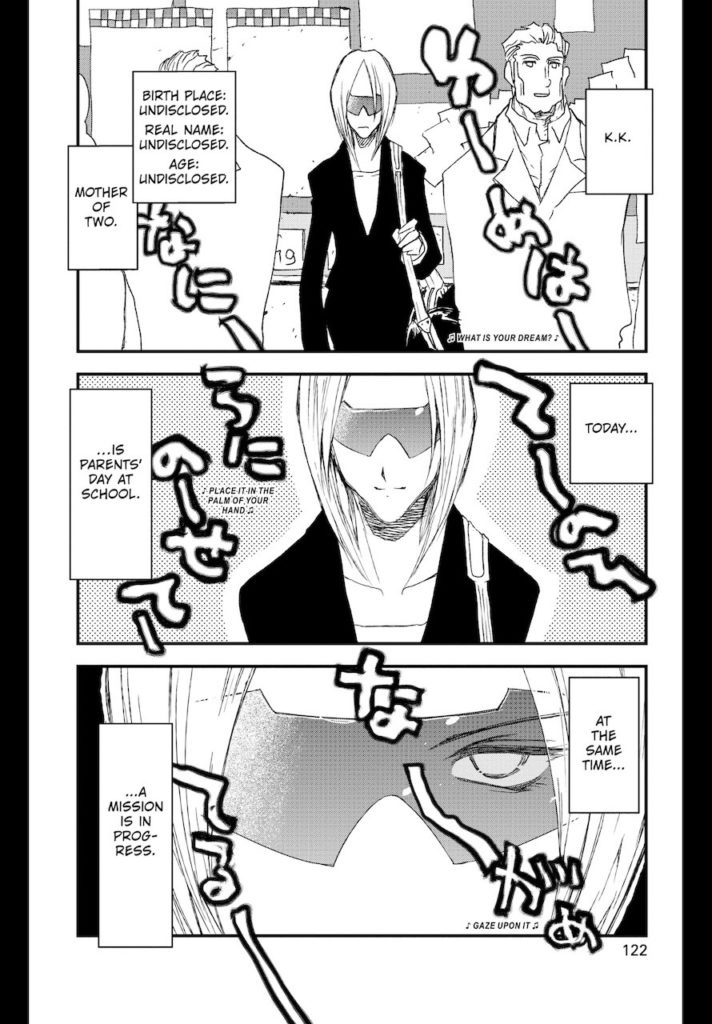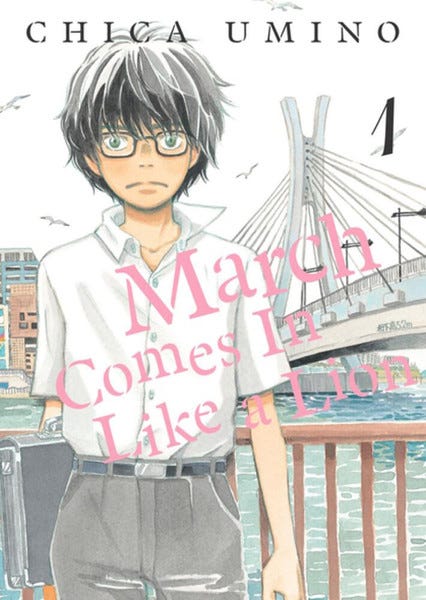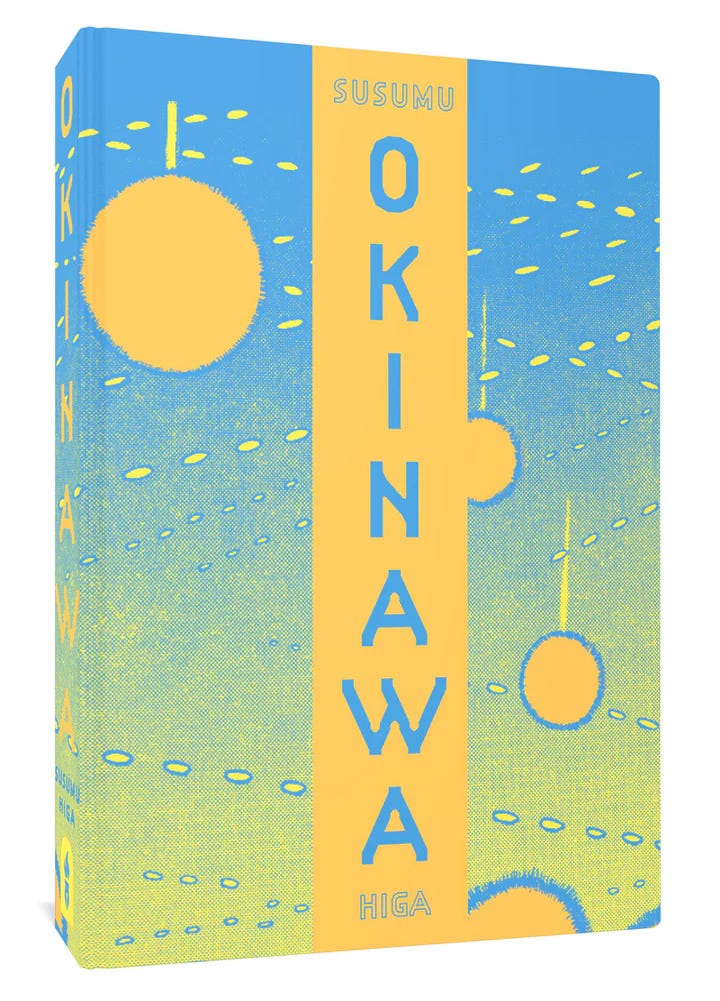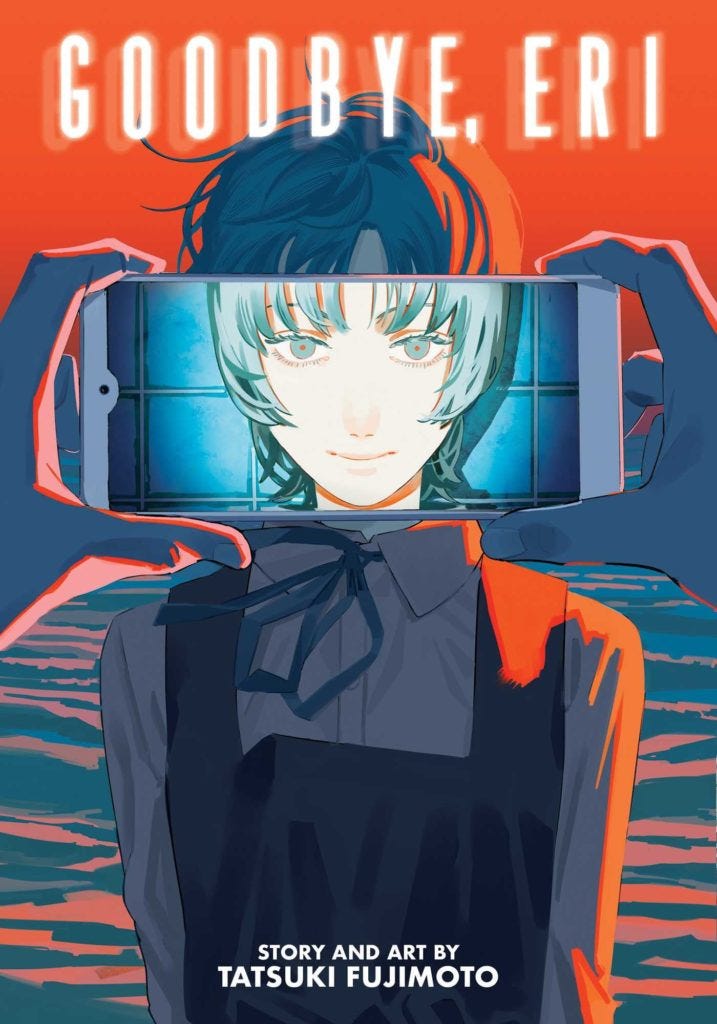Ep. 104: Blood Blockade Battlefront Vol. 1, by Yasuhiro Nightow
A manga take on stylish superheroes gets a mixed response
Is this manga meets X-Men: Inferno? That’s how David pitched Blood Blockade Battlefront by Trigun creator Yasuhiro Nightow to good ‘ole Chip, but will this over the top spectral superhero series live up to that moniker? Only one way to find out…!
Listen and Subscribe to the Podcast:
Google | Apple | Stitcher | RedCircle | Amazon | Radio Public | PocketCast | Spotify
IN THIS EPISODE
00:00 Blood Blockade Battlefront vol. 1
57:00 THE BREAK
57:30 SHOUT-OUTS: a kinda sports manga, a kinda sports doujinshi, a shameless plug, a TV show and kinda sci-fi movie
Blood Blockade Battlefront vol. 1 by Yasuhiro Nightow
Translated by: Matthew Johnson
Lettering and retouch: Studio Cutie
Editor: Chris Warner
Published by Dark Horse. Available in print / digital
Audio editing by David Brothers. Show notes by Deb Aoki and Christopher Woodrow-Butcher
BEFORE WE GET STARTED
[Christopher:] Hey all! Deb took the lead on this week’s show notes, so just read the whole thing in her voice unless I preface a paragraph with my name. 🙂
ABOUT YASUHIRO NIGHTOW
Here’s Dark Horse’s bio of Yasuhiro Nightow
Yasuhiro Nightow is a Japanese manga artist and game creator who created the anime and manga Trigun. Nightow was born on April 8, 1967, in Yokohama, Japan. He moved to Yokosuka when he was in elementary school and spent his junior high and high school years in Shizuoka.
Before the release of the popular manga Trigun, Nightow studied social science and then majored in media studies. Nightow became popular in the United States thanks to the US release of Trigun. Trigun, the TV series, had a limited broadcast run in 1998. Nightow also created the characters and story for the Sega/Red Entertainment anime and third-person shooter video game series Gungrave. The author lives in Tokyo, Japan.– Dark Horse Comics
[Christopher:] Nightow is a really interesting creator, one of the few manga-ka that admit to being directly influenced by the work of North American comics creators. It’s no wonder that Nightow’s characters Vash The Stampede was part of McFarlane Toys (by Spawn creator Todd McFarlane)’s first line of anime figures all the way back in 2000, alongside characters from Akira and Ghost in the Shell.
Nightow’s career started in doujinshi, licensed comics, and short stories, and he’s stayed active in and around the doujin scene. But really, his career in comics is almost entirely defined by Trigun and Blood Blockade Battlefront, with occasional forays into work in video games, design, and illustration. He’s also involved in the various anime adapting his work, and seems to keep quite busy. Still, he does maintain an active Twitter presence, and you can find him online at https://twitter.com/nightow.
1:06 Here’s the description of this first volume of Blood Blockade Battlefront, courtesy of Dark Horse:
Trigun creator Yasuhiro Nightow returns to Dark Horse with a frantic new mini-series!
A breach between Earth and the netherworlds has opened up over the city of New York, trapping New Yorkers and creatures from other dimensions in an impenetrable bubble. They’ve lived together for years in a world of magic, monsters, and madness. Now someone is threatening to breach the bubble, and a group of stylish superhumans is working to keep it from happening.
An action-packed supernatural science-fiction steamroller as only Nightow can conjure!Dark Horse Comics
01:49 David describes this story as “What if X-Men Inferno kept happening?” Please explain this one, Christopher…
[Christopher:] So X-Men: Inferno was how David originally pitched this title, and the connection is kind of glossed over here… But it really is apt! The X-Men had a line-wide crossover through all of the different X-Men comics back in 1989, and with those books, plus spin-offs into the main Marvel Universe, 70 comics were released with “Inferno” branding, mostly written by Chris Claremont and edited by Bob Harris.
It’s a huge storyline. The conceit was that–seriously–the clone of Jean Grey, Madeline Pryor, sells her (soul? sort of? or maybe she was always a plant? it was retconned?) to some demons and also an evil mutant by the name of Mr. Sinister, and becomes the Goblin Queen. She sort of infects New York with demons from hell, and it’s up to many different teams of X-Men to fix things. NYC is slowly transformed into a demonic version of itself. The Goblin Queen doesn’t wear very many clothes (as you can see from the covers above), but in a nice twist, neither does her consort, Alex Summers AKA Havok AKA The Goblin Prince AKA her Ex-Husband Cyclops’s Younger Brother (#itscomplicated). Equal opportunity! No wonder I loved these issues so much as a young man. 😉
But the X-Men teams, the demons, and then New York City are featured, and are very memorable in this story. You can see the very direct comparison to Blood Blockade Battlefront without much effort. Also, it’s worth noting that there have been two additional stories called X-Men: Inferno, one in 2008 by C.B. Cebulski, and one in 2022 by Jonathan Hickman. I have read neither.
Surprising no one, I went and checked and X-Men: Inferno is not in print. Oh Marvel Comics, you never surprise. Maybe you can read it digitally.
02:27 That reveal that made David laugh really hard is this particular twist – a case of mistaken identity due to an upside down photo!
03:27 How can we begin to explain how messed the pagination is in the the Comixology version of Blood Blockade Battlefront compared to the Dark Horse digital version? First, the Amazon Kindle/Comixology version of pages 158-161:
Now, here’s pages 158-161 from the Dark Horse Digital version:
[Christopher:] Yeah, Dark Horse, I really need you to fix Blood Blockade Battlefront’s digital edition on Comixology. It is set in the Western orientation in the online reader and it makes it so, so awkward to read.
06:40 That mention of a “Tex Avery pause where Bugs Bunny looks at the camera and says, ‘Ain’t I a lil’ stinker?” is a reference to Tex Avery (nee Frederick Bean Avery) is a legendary animator who is responsible for many Warner Brothers’ Looney Toons animated shorts that are considered some of the best examples of animated slapstick humor.
The “Ain’t I a stinker?” line usually comes up when Bugs Bunny does something to Elmer Fudd that puts the cherry on top of what ever mayhem he has inflicted on that bald-headed hunter. Here’s a short clip, after Bugs has buried Fudd in a hole.
07:20 David mentions that “Nightow has been very vocal about how much he like Todd McFarlane’s Spawn.” and it shows in how he draws capes and cloaks on Vash the Stampede and other characters in his other series, Trigun.”
[Christopher:] Check out this animated sequence from Trigun’s opening credits to see what we mean.
It goes both ways too, as this cover of Todd McFarlane’s Gunslinger Spawn is clearly an homage to Trigun.
07:40 The Blood Blockade Battlefront anime is streaming on Crunchyroll.
08:12 Chris refers to that opening scene (in the manga) where you zoom in and see that not all the people are people. It breathes a little more in the anime.
08:24 Christopher brings up how the anime version of Sailor Moon is a bit different than the ‘idiosyncratic art style of Naoko Takeuchi”.
[Christopher:] Yeah, here’s just a page of the Sailor Moon manga next to what the anime looked like when it originally came out. Night and day difference between those character designs on a page, and as something that needs to be animated by a team of people.
You can see with these couple of pages from the sailor Moon manga, that the style is more concerned with being bold and graphic and emotive than necessarily working in 3D space. It’s really interesting manga.
But then when you look at the anime, the anime character designs have been simplified, and made to work in 3d space. You need the designs to work in 3d so you can make toys, animated turnarounds, etc.
Obviously, you can still play with squash and stretch, deformation, and doing some fun 2d stuff, but the designs have definitely been codified and simplified here, and that’s generally what happens with anime.
Sailor Moon is an interesting example of the manga/anime adaptation dynamic, because a later anime adaptation pushed the character designs closer to the original art (seemingly at the author’s request!) and that’s Sailor Moon Eternal. If we ever get invited out to a con, when all four of us can be in the same room, we should do a whole panel on Sailor Moon…
09:40 Chip mentions that there’s so much text on page 38, the cluttered look ruins the design of the page.
Also on page 50: “Oh my god, there’s so much going on!”
13:39 [Christopher:] If you’re keeping score out there, here’s the short list of Mangasplaining episodes where Deb got MAD at how confusing or weird or whatever that week’s book was: 1. Franken Fran, 2. Dai Dark, and now 3. Blood Blockade Battlefront.
14:00 [Deb:] If you missed Trigun back in the day, good news! The series (which has been OOP for a long while now) is going to get that big, chunky deluxe hardcover treatment like Berserk. This is the cover art that Dark Horse shared when they first made the announcement, but have since been using a place holder “Cover art not final” in the pre-order pages. We’ll see what it ends up looking like later, I guess.
18:27 [Christopher:] I talk a lot about Crying Freeman by Ryoichi Ikegami and Kazuo Koike here, and also when something is “manga-y” versus “anime-y”. I think I actually do a good job of explaining what I meant here, with something “feeling” like manga. But basically, once you read enough manga, enough comics really, you can start to see when the artist drew something or created a plot point that would be so hard to animate… and they just don’t care and do it anyway. For the creator, the manga is the final work, it’s not being made hoping to get adapted into something else some day.
Anyway, it’s a pretty fun manga, deeply problematic in 2023 for multiple reasons, but maybe we’ll read it for the podcast one day, I think Chip would dig Crying Freeman.
22:30 David mentions that Nightow simplified his linework in Blood Blockade Battlefront compared to Trigun.
Trigun Vol 1. You can definitely see a change in Nightow’s art here, versus the much chunkier BBB.
23:50 David references a chapter in volume 5 called “Don’t Forget to Forget About Me” where the mushroom character, AKA “Amagranoff Luozontam Ouv Lee Nej” likes burgers and chills, and also releases a cloud of spores that force people to forget him, so he can’t make friends.
25:57 – Deb mentions that Nightow switched publishers from Shonen Gahosha, where he published Trigun and Trigun Maximum, when he started serializing Block Blockade Battlefront for Shueisha’s Jump SQ magazine, which is also the home of Blue Exorcist by Kazue Kato.
29:10 Chip refers to the scene where the building gets sliced on pages 54-55:
30:44 David mentions the scenes starting on pages 150 – 152 when Leonardo and Zapp Renfro ride a scooter together and encounter a dry cleaning truck that’s actually something else in disguise.
This reminds Deb of the Munsters wagon designed by George Barris, a.k.a. “The King of the Kustomizers,” a well-known customized car maker for movies and TV shows in the 1960s-70s. One of his best known creations is the Batmobile (of course) from the very campy Batman TV series of the 1960s, but also the Munsters Koach, from the sitcom about a family of monsters.
And yes, there’s model car kits for these creations!
Grandpa Munster also had a coffin-shaped car called “Drag-ula” that was the inspiration for this Rob Zombie song of the same name.
[Christopher:] Which in turn inspired the Boulet-Brothers Drag Show of the same name!
31:09 The anime closing song of Blood Blockade Battlefront that David says “took Japan by storm” is Sugar Song to Bitter Step by Unison Square Garden:
32:50 [Christopher:] There’s three “seasons” (for lack of a better word) of the Blood Blockade Battlefront manga now.
The first, which we’ve read this week, is Blood Blockade Battlefront, published in Jump SQ from 2009-2015, and released in 10 volumes. This has been completely published in English by Dark Horse Comics.
The second series is a direct sequel, Blood Blockade Battlefront: Back 2 Back, serialized in two different spin-off magazines, Jump SQ Crown and Jump SQ. Rise, from 2015-2022. These volumes have not yet been published in English.
Finally, Nightow-sensei’s newest iteration of the series debuted in October 2022. Entitled Blood Blockade Battlefront: Beat 3peat, it also is currently not available in English, not even on like the Manga Plus app or something. There’s 1 tankoubon out now. It’s nice looking!
[Deb:] Sorry, it turns out that Dark Horse has NOT yet announced plans to publish this latest batch of Blood Blockade Battlefront stories. We can wait and hope. Speaking of waiting, I’ll eventually post the transcript of this year’s Manga Publishers Panel at SDCC. I hope?
34:40 Here’s an example of those fight scenes in Blood Blockade Battlefront and there’s like 5-6 VERY BIG, VERY COMPLICATED LOOKING KANJI to show that the characters are executing a bad-ass fighting move. Note the very tiny translation of the characters beneath each one.
35:10 [Christopher:] We love a good author’s note comic, or “omake” in the back of a volume, and BBB doesn’t disappoint. The most interesting bit to me was that Nightow reveals that this is the series where he started to draw digitally, rather than traditionally.
36:11 – David mentions that compared to volume 1, volume 10 has fewer panels per page, on average… Here’s an example:
38:40 As David describes it, Blood Blockade Battlefront has the “hot girl who’s kind of a dick to the main character who has a similar character design as a popular male character in Trigun…” (Nicholas D. Wolfwood). Besides sharing simiilar tastes in clothes, they might as well be siblings!
39:40 Chris mentions “grotesque monster deaths,” and for a taste of that, here’s pages 122-123.
40:35: [Christopher:] So what is the difference between a Shueisha shonen manga title, and a Kadokawa shonen manga series and a Kodansha shonen manga series? I don’t know if it can be summed up succinctly… But there’s a reason that Japanese folks, especially boys, pledge allegiance to their magazine of choice as a young person, and follow that magazine (and it’s older-demographic-targeted sister magazines) through their manga reading careers. Were you a mainstream Shueisha JUMP kid? An edgy Kodansha SHONEN mag kid? One of those weirdoes who bought Kadokawa’s Shonen ACE? Or lord help you, Square Enix’s GANGAN…? It’s like the Marvel vs. DC of Japan. 😉
40:41 David refers to our episode on Chainsaw Man. If you haven’t listened to it yet, well, here it is!
PODCAST: Ep. 85 - Chainsaw Man vol 1 by Tatsuki Fujimoto
Welcome back to Mangasplaining, the podcast where we recommend manga to folks who haven’t read much manga before! We’re kicking off Season 4, a.k.a/ episode 85, with the biggest manga out there right…
43:00 [Christopher:] Yeah, if you’re into Yaoi/BL and also like to read Shonen Jump, I’ve got good news for you about the doujinshi (fan-made comic scene) in Japan. In addition to the JUMP room at Comiket, there’s also whole doujinshi events that are JUST for JUMP manga, just as there are for JUNE/BL, and even individual popular comic and game properties get their own shows too. For now though, here’s some Klaus doujinshi artwork, and you can type more into google if you need more.
45:47 Leonard can’t imagine having to kill the monkey to save the world. It’s so horrible, Nightow pixelates it to spare readers the sight of the gory possibilities.
Well, that monkey is kind of cute, so I guess it’s understandable that he’d be reluctant to kill it?
46:18 Christopher mentions that the mushroom guy was quite popular as a mascot, though not nearly as popular as the cat from Nightow’s previous series, Trigun.
46:50 From page 119: “Why didn’t he kill it??”
48:14 David refers to the character on the cover of Blood Blockade Battlefront vol. 7 as being “a hot fish dude” like Abe Sapien, and Chip agrees.
49:11 [Christopher:] Yeah, Toronto often plays New York City (and Chicago!) in films, due to some pretty good tax credits, a weaker Canadian dollar, and for, uh, safety reasons, a lot of a time. as a filming location for movies. Some good movies, some very bad movies too. As Chip said, it’s a rite of passage for Toronto residents to be walking down the street and see a New York City cab parked, and realize you’ve stumbled into a movie set. It’s a little bit of why Torontonians were so excited for the Scott Pilgrim movie, because Toronto got to play itself for a change.
Here’s a listicle that pulls back the curtain on just some of the films shot in the city that pretended to be somewhere else.
50:12 Christopher refers to the anime series FLCL, which has a kind of manic over the top energy (and incredible animation and art!) that gives off a similar feeling to BBB.
[Christopher:] I’m being a bit mean here, saying that there’s only one FLCL 6 episode series, but it’s such a perfect piece of media it didn’t really need a sequel, IMHO. Anyway, there are seasons 2 and 3, created as North American co-productions years later that are available to watch now. And the trailer for season 4, FLCL Shoegaze, was just dropped.
[Deb:] Dark Horse has the manga version of FLCL by Hajime Ueda, and I vaguely remember either Carl Horn or Michael Gombos mentioning that it is a rare example of a manga that sold more copies in English than in Japanese (or something like that).
53:00 How to Pen & Ink: The Manga Start-up Guide features artwork and tips from Yasuhiro Nightow, along with Oh! Great (Air Gear) and Satoshi Shiki (Attack on Titan: Before the Fall). It was published by DMP back in the day. It’s quite out of print, but worth looking for.
54:05 David mentions a blonde housewife character called KK that shows up in volume 2. Here she is:
55:48 Trigun Stampede, the new, updated hot guy version of Trigun that was recently released. It looks great and set off a whole new generation of Trigun (mostly slash) fanart. It's currently streaming on Crunchyroll.
57:00 THE BREAK!
57:30 SHOUT OUTS!
DEB picks March Comes in Like a Lion manga by Chica Umino, from Denpa. A high schooler who just happens to be a professional shoji (Japanese chess) player lives alone in an apartment in Tokyo but finds the unconditional love and warmth that he never had from his adoptive family when he meets a trio of sisters who live across the river from him. It’s very heartwarming and surprisingly dramatic.
There’s an anime series of this manga that’s now streaming on Crunchyroll and Netflix, and available from Aniplex.
[Christopher:] Probably the best thing about the Japanese used book store Mandarake is that, if they’ve ever sold something, even if it’s sold out, they tend to leave an entry for it in their database. So even if you moved to the other side of the world, you can still find where it used to be on their website, a decade or two ago.
So while Chica Umino made a whole bunch of Slam Dunk doujinshi that looks like you think it would:
She also created this free give-away notebook situation, probably as a gag or as a gift with purchase at a show, and it’s just awesome. Enjoy.
CHRISTOPHER shouts out Okinawa! Now out in print! Yay!
[Christopher:] You can read two chapters over at Mangasplaining Extra, and it’s been getting a TON of great press!
You can tell when this was recorded, BTW, as we were mentioning that this book wasn’t out yet, and that Comic-Con was coming up soon. So early July? Posting the show got a little weird over the summer.
CHIP shouts out a TV show on Comedy Central, The Other Two.
DAVID gives a shout-out to Wes Anderson’s Asteroid City movie:
Deb adds in that Dark Horse has the graphic novel adaptation of Wes Anderson’s Isle of Dogs drawn by Minetaro Mochizuki, the creator of horror manga, Dragon Head (once published by TokyoPop, now available in digital from Kodansha)
And that’s this week in Mangasplaining! This episode is also available wherever you get your podcasts, so please subscribe and leave a review, so others can discover our show. Also, if you’d like to get the latest episode delivered straight to your inbox along with exclusive interviews, articles and new chapters of manga you can’t read anywhere else, subscribe to our Substack newsletter.
Get ready for our Goodbye Eri, a one-shot by Tatsuki Fujimoto, creator of Chainsaw Man and Look Back.
Thanks so much for listening! Please support your local comic and manga specialty shop when purchasing these books, and you can find one near you at comicshoplocator.com. You can also check your local library for print and digital lending options, they have TONS of manga! Finally, thanks to D.A.D.S. for their musical accompaniment for this episode.

